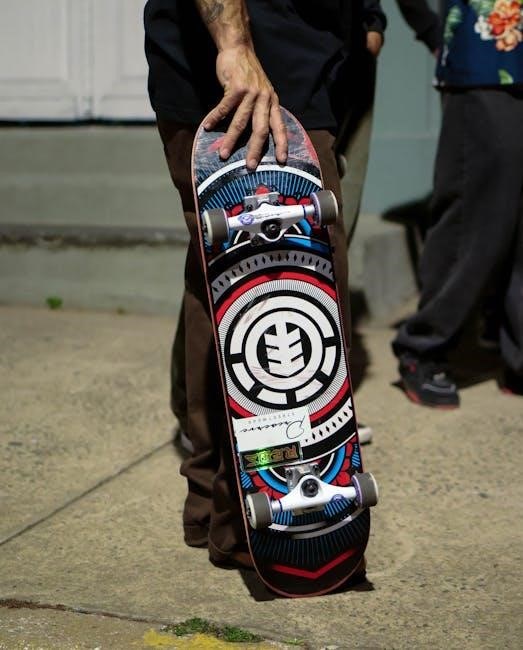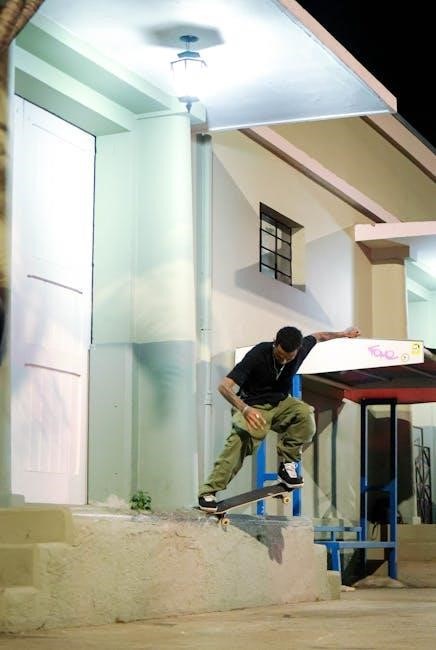
This guide helps you choose the right skateboard size based on age, height, skill level, and personal preference, ensuring optimal performance and comfort for every rider․
1․1 Importance of Skateboard Size
Skateboard size is crucial for comfort, performance, and safety․ A board that is too small may lack stability, while one that is too large can be difficult to maneuver․ Proper size ensures better balance, easier trick execution, and a more enjoyable ride․ It also affects weight distribution and control, making it essential for riders of all skill levels․ Choosing the correct size enhances the overall skateboarding experience and helps prevent discomfort or accidents․ Personal preference and riding style further highlight the importance of selecting the right size for optimal results․ Skateboard size plays a significant role in determining the quality of the ride and the rider’s ability to progress in their skills․ It is a fundamental aspect of skateboarding that should be carefully considered for the best experience․
1․2 Brief History of Skateboard Development
Skateboarding has evolved significantly since its origins in the 1950s in California․ Early skateboards were crafted by attaching roller skate wheels to wooden boards, often by surfers seeking a land-based alternative․ These primitive designs laid the foundation for modern skateboards․ Over the decades, advancements in materials and design transformed the sport․ The 1970s introduced urethane wheels, improving grip and durability, while the 1980s saw the rise of trick skating and the development of the ollie, which influenced deck shapes and sizes․ The 1990s and 2000s brought street skating to prominence, further diversifying board designs․ Today, skateboards are tailored to specific styles, from street to longboarding, with sizes and shapes optimized for performance and comfort․ This evolution underscores the importance of choosing the right size for individual needs, ensuring the best possible riding experience․
1․3 Purpose of This Guide
This guide is designed to provide comprehensive insights into selecting the appropriate skateboard size, catering to riders of all skill levels and preferences․ It aims to simplify the process of choosing the right board by breaking down key factors such as deck size, width, and length, and how they relate to age, height, and riding style․ By understanding the relationship between these elements, riders can enhance their performance, comfort, and overall skating experience․ Whether you’re a beginner or an experienced skateboarder, this guide offers practical advice to help you make an informed decision․ It ensures that you find the perfect fit for your needs, enabling you to enjoy the sport to the fullest․ With clear and structured information, this guide serves as an essential resource for anyone looking to optimize their skateboard setup․

Understanding Skateboard Size

Skateboard size is crucial for optimal performance and comfort․ It involves understanding deck width, length, and how these dimensions impact riding style, stability, and maneuverability for different skaters․
2․1 Deck Size and Its Impact
The deck size of a skateboard plays a pivotal role in determining its performance and suitability for different riders․ The width and length of the deck directly influence stability, maneuverability, and how tricks can be executed․ A narrower deck is ideal for younger skaters or those with smaller feet, as it provides better control and ease of handling․ Conversely, wider decks are preferred by older or taller riders, offering greater stability and comfort during tricks and cruising․ The length of the deck also matters, with longer boards providing more space for foot placement, which is beneficial for taller individuals․ Deck size should align with the rider’s age, height, and skill level to ensure optimal performance․ Additionally, personal preference plays a significant role, as some riders may prioritize agility over stability or vice versa․ Choosing the right deck size enhances the overall skating experience, making it essential to consider these factors carefully․
2․2 Width of the Skateboard Deck
The width of a skateboard deck is a critical factor in determining its performance and comfort․ A wider deck provides greater stability, making it easier to balance and perform tricks, while a narrower deck offers more agility and maneuverability․ The width typically ranges from 7․5 inches to 10 inches, with narrower boards suited for younger or smaller-footed riders and wider boards preferred by taller or heavier individuals․ The width also influences the board’s responsiveness, with narrower decks being more sensitive to foot movements and wider decks offering a more stable platform․ Ensuring the deck width aligns with the rider’s foot size and skating style is essential for optimal control and comfort․ Personal preference also plays a significant role, as some riders may prioritize stability over agility or vice versa․ Deck width is a fundamental aspect of skateboard design that directly impacts the riding experience․
2․3 Length of the Skateboard Deck
The length of a skateboard deck plays a significant role in its overall performance and suitability for different riding styles․ Typically, skateboard decks range in length from 28 to 32 inches, with variations designed to cater to specific needs․ Longer decks, often found in cruiser or longboard styles, provide greater stability at higher speeds and are ideal for commuting or carving․ Shorter decks, commonly used in street or trick skating, offer enhanced maneuverability and ease of handling, making them perfect for tight spaces and technical tricks․ The length of the deck also influences the board’s responsiveness, with shorter boards being more agile and longer boards offering a smoother ride․ Riders should consider their skating style, preferred terrain, and personal comfort when selecting the appropriate deck length, as it directly impacts the overall riding experience and functionality of the skateboard․

Choosing the Right Skateboard Size
Selecting the right skateboard size involves considering age, height, skill level, and personal preference to ensure optimal comfort, performance, and ease of use for every rider’s unique needs․
3․1 Skateboard Size by Age Group
Choosing the right skateboard size by age group is essential for comfort and performance․ For younger riders, typically under the age of 5, smaller decks (around 7 inches wide) are recommended to ensure ease of control and maneuverability․ As children grow older, between 6-8 years, deck widths can gradually increase to 7․5-8 inches to accommodate their developing strength and balance․ Teenagers and adults usually opt for standard sizes, ranging from 8-8․5 inches, depending on their height and skill level․ Age is a key factor, but individual characteristics like height and skating style should also be considered․ Using a size chart or seeking advice from experienced skaters can help narrow down the best fit․ Ultimately, the right size enhances the learning experience and overall enjoyment of skateboarding․
3․2 Skateboard Size by Height
Height plays a significant role in determining the ideal skateboard size, as it ensures proper balance and control․ Generally, shorter riders (under 5’5″) benefit from narrower decks (7․5-8 inches), allowing easier maneuverability․ For average heights (5’5″-5’10”), a standard deck width of 8-8․25 inches is recommended, providing a balanced feel․ Taller riders (5’11” and above) often prefer wider decks (8․25-8․5 inches) for stability and comfort․ While height is a good starting point, personal preference and skating style should also be considered․ For example, taller riders who prefer street skating might opt for narrower decks for better agility․ Using a size chart tailored to height can help narrow down the best fit, ensuring the skateboard feels natural and easy to handle․ This approach enhances both performance and overall skating enjoyment․
3․3 Skateboard Size by Skill Level
Skateboard size is closely tied to skill level, as different riding styles require specific deck dimensions․ Beginners benefit from wider decks (7․75-8․5 inches) for added stability and easier balance․ A wider deck provides more foot space, making it less likely for the board to slip out from under the rider․ For intermediate skaters, standard widths (8-8․25 inches) are ideal, offering a balance between stability and maneuverability․ Advanced riders often prefer narrower decks (7․5-8 inches) for technical tricks and tighter control․ Skill level dictates how comfortable a rider will feel on the board and how easily they can perform maneuvers․ Choosing the right size based on skill ensures better performance, reduces the risk of accidents, and enhances overall skating confidence․ This tailored approach helps riders progress smoothly, whether they’re learning basics or mastering advanced techniques․
3․4 Personal Preference in Size
Personal preference plays a significant role in selecting skateboard size, as it directly impacts comfort, performance, and overall satisfaction․ Some riders prefer wider decks for stability and ease of landing tricks, while others opt for narrower boards for better maneuverability and portability․ The choice often depends on individual riding style, whether it’s street skating, cruising, or vert skating․ Riders who prioritize comfort may lean toward larger decks, while those who value aesthetics or brand loyalty might choose sizes that align with their personal taste․ Additionally, personal preference influences the feel of the board, with some skaters favoring softer or stiffer setups․ Ultimately, the right size is one that feels natural and allows the rider to perform at their best․ Balancing personal preference with practical considerations ensures a skateboard that is both functional and enjoyable to ride․

Types of Skateboards
Skateboards vary in design, catering to different styles and preferences․ Common types include street, cruiser, and longboard skateboards, each suited for specific riding purposes and terrains, ensuring versatility for all skaters․
4․1 Street Skateboards
Street skateboards are designed for versatility and durability, catering to skaters who enjoy performing tricks, grinding, and navigating urban environments․ Typically measuring between 7․5 to 8․5 inches in width, these boards are ideal for skaters of all skill levels, from beginners to professionals․ Their compact size allows for easier maneuverability and control, making them perfect for street skating, skate parks, and technical tricks․ The width of the deck plays a crucial role in comfort and performance, with narrower boards offering better flipability and wider boards providing more stability․ Street skateboards are a popular choice for those who appreciate the freedom of skating in various settings, from sidewalks to skate parks; Whether you’re mastering ollies or grinding rails, a street skateboard is a reliable companion for any skater looking to push their limits and explore the world of street skating․
- Narrower width for better trick performance․
- Suitable for urban and park environments․
- Popular among skaters of all skill levels․
4․2 Cruiser Skateboards
Cruiser skateboards are designed for comfort and stability, offering a relaxed riding experience․ Typically wider than street skateboards, they range from 8․5 to 10 inches in deck width, providing a spacious platform for foot placement․ These boards are ideal for cruising, commuting, or casual rides on flat surfaces․ Cruiser skateboards often feature softer wheels for a smoother ride and better grip, making them perfect for longer distances․ Their larger size and design cater to skaters who prioritize comfort and stability over trick performance․ Whether you’re gliding through the streets or enjoying a leisurely ride along the beach, cruiser skateboards offer a fun and laid-back experience․ They are particularly suitable for taller or heavier riders who need a more robust and comfortable setup․ Cruiser skateboards embody the essence of relaxed, enjoyable skating, making them a great choice for those who value ease and comfort․
- Wider deck for enhanced stability․
- Softer wheels for a smoother ride․
- Ideal for commuting and casual cruising․
4․3 Longboard Skateboards
Longboard skateboards are designed for speed, distance, and smooth riding, making them a favorite among commuters and downhill enthusiasts․ With deck lengths typically ranging from 33 to 46 inches, longboards provide exceptional stability at higher speeds․ Their wider decks, often measuring between 9 to 14 inches, offer ample foot space and comfort for riders․ Longboards are perfect for carving, cruising, or racing, and they often feature specialized trucks and wheels for enhanced maneuverability and control․ The larger size and construction of longboards make them ideal for taller or heavier riders seeking a stable and efficient ride․ Whether navigating urban landscapes or shredding downhill, longboards deliver a thrilling and smooth experience․ They are a versatile option for skaters who value speed, durability, and performance over trick-oriented skating․
- Longer deck for stability and speed․
- Wider platform for comfort and control․
- Perfect for commuting, carving, and downhill racing․

Factors Influencing Skateboard Size
Skateboard size is influenced by age, height, weight, skill level, and personal preference, ensuring optimal performance, balance, and comfort for riders of all levels․
- Age and height guide deck size selection․
- Weight affects balance and stability․
- Skill level determines deck width and length․
- Personal preference enhances riding comfort․
5․1 Deck Width and Comfort
Deck width significantly impacts comfort and performance, as it determines how well a rider can stand and maneuver․ A wider deck provides more stability and comfort for larger feet or those preferring a spacious platform, while narrower decks are ideal for tricks and street skating․ Riders with smaller feet or who prioritize agility often opt for slimmer decks․ Personal comfort also plays a role, as some riders prefer the feel of a specific width․ Shoe size and riding style further influence this choice, with wider decks accommodating bulkier shoes․ Ultimately, the right deck width ensures optimal balance, control, and enjoyment, making it a crucial factor in selecting a skateboard․ Proper fit enhances the overall skating experience, whether cruising, performing tricks, or carving through terrain․
- Wider decks offer stability and comfort for larger feet․
- Narrower decks suit tricks and street skating․
- Personal comfort and shoe size influence deck width choice․
- Proper fit enhances balance, control, and enjoyment․
5․2 Weight and Balance
Weight and balance are critical factors in skateboard size selection, directly affecting performance and maneuverability․ A skateboard that is too heavy can be difficult to control, especially for younger or less experienced riders, while a lighter board allows for easier tricks and faster movements․ Balance is achieved by ensuring the deck’s width and length align with the rider’s stance and body proportions; Proper weight distribution helps riders maintain stability, whether cruising or performing technical maneuvers․ Additionally, the skateboard’s components, such as the trucks and wheels, play a role in overall weight and balance․ Opting for a setup that matches the rider’s weight and skill level ensures better control and a more enjoyable skating experience․ Finding the right balance between weight and responsiveness is essential for maximizing performance and comfort․
- Lighter boards are easier to maneuver for tricks and speed․
- Balance depends on deck size and rider proportions․
- Weight distribution impacts stability and control․
- Components like trucks and wheels affect overall weight․
- Matching board weight to rider skill enhances performance․
5․3 Skill Level and Performance
Your skill level significantly influences the ideal skateboard size and setup․ Beginners benefit from wider, more stable decks, which provide better balance and control․ Intermediate riders often prefer standard-sized decks that allow for easier maneuverability and trick performance․ Advanced skaters may opt for narrower or shorter decks, enabling precise control and technical tricks․ The stiffness of the deck also plays a role, with stiffer decks offering better pop for tricks․ Additionally, component choices, such as wheel hardness and truck tightness, should align with your skill level to enhance performance․ For example, softer wheels are better for cruising, while harder wheels suit technical skating․ Ensuring your skateboard size and components match your abilities ensures a more enjoyable and effective skating experience․
- Beginners: Wider decks for stability and control․
- Intermediate: Standard decks for balance and tricks․
- Advanced: Narrower decks for precision and technical moves․
- Deck stiffness and component choice matter for performance․

Maintenance and Upkeep
Regular cleaning, lubricating bearings, and replacing worn-out parts ensure your skateboard’s longevity and optimal performance․ Proper upkeep keeps your board in great condition for years of smooth skating․

6․1 Cleaning the Skateboard
Cleaning your skateboard is essential for maintaining its performance and longevity․ Start by removing loose dirt and debris from the deck, wheels, and trucks using a soft-bristled brush or a dry cloth․ For tougher dirt, mix mild soap with warm water and gently scrub the areas with a sponge or cloth․ Avoid using harsh chemicals or excessive water, especially near the bearings, as this can damage the components․ After cleaning, dry the skateboard thoroughly with a clean towel to prevent rust or moisture buildup․ Regular cleaning ensures smooth operation and keeps your board in prime condition for years of skating․

6․2 Lubricating the Bearings
Lubricating your skateboard bearings is crucial for smooth performance and longevity․ Bearings collect dirt and dust over time, which can cause friction and wear․ Regular lubrication reduces friction, ensuring faster and quieter rides․ Use a high-quality skateboard bearing lubricant, as it is specifically designed for this purpose․ Apply a few drops directly to the bearings, gently spinning them to distribute the lubricant evenly․ Avoid over-lubricating, as excess oil can attract more dirt․ For optimal maintenance, clean the bearings before applying new lubricant․ Proper lubrication not only enhances performance but also protects your bearings from corrosion and premature wear․ By keeping your bearings well-lubricated, you ensure a smoother, more responsive ride and extend the life of your skateboard․

6․3 Replacing Worn-Out Parts
Replacing worn-out parts is essential for maintaining your skateboard’s performance and safety․ Over time, components like the deck, wheels, trucks, and bearings can wear out due to heavy use․ Identify worn parts by inspecting for cracks, excessive wear, or reduced functionality․ For example, if the deck is chipped or soft, or the wheels are uneven, it’s time to replace them․ Trucks with loose bolts or uneven alignment also need attention․ Bearings that are slow or noisy may indicate they need to be replaced or cleaned․ Regularly replacing worn-out parts ensures your skateboard remains responsive and safe to ride․ Neglecting these replacements can lead to poor performance or even accidents․ Always use high-quality replacement parts that match your skateboard’s specifications for optimal results․ By keeping your skateboard in good condition, you extend its lifespan and enjoy a smoother, more enjoyable ride․
